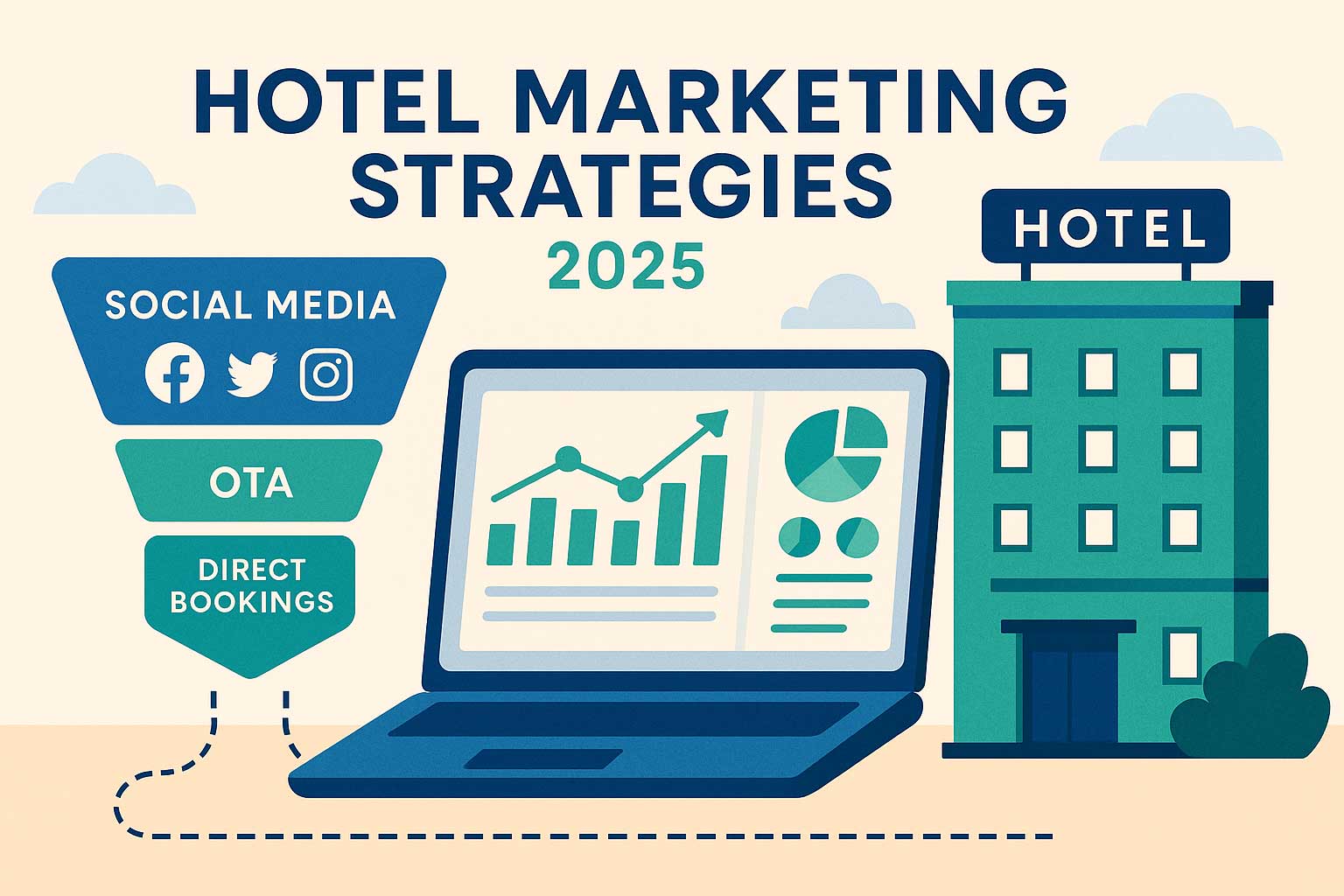Hotel Compset: Guide to Building & Using Your Competitive Set
Aug 29, 2025
 Mika Takahashi
Mika TakahashiPopular Categories
Hotel Technology & InnovationHotel Operations OptimizationDigital MarketingIndustry TrendsRevenue ManagementHospitality Industry
Popular Categories
Trending Post

Hotel Walk Letter Template: Professional Guest Communication

Online Travel Agents: What They Are and How They Work

Hotel Security Systems: Modern Protection Solutions

Hotel Advertising: Complete Guide to Boost Bookings and Revenue

25 Hotel Marketing Strategy Ideas for 2025: Complete Guide

AI Reservation Agent: Revolutionizing Hotel Booking and Guest Experience

PMS Communication: Streamlining Property Management Through Effective Guest Messaging
Table of contents
In the hotel industry, thriving means knowing your competition just as well as you know your own property. While many hotel operators focus mainly on their own performance, the truly successful revenue managers understand that context is everything. That’s where your hotel compset becomes an invaluable strategic tool.
A thoughtfully built hotel competitive set lays the groundwork for smarter pricing strategies, marketing choices, and operational improvements that can make a real difference to your hotel’s success. Research shows that over 93% of hoteliers keep a close eye on their compset’s rates and guest reviews to guide important business decisions.
This all-in-one guide will take you through what you need to know about creating, analyzing, and making the most of your hotel compset to boost revenue and stay ahead of your direct competitors. You’ll learn proven ways to pick the right competitors, avoid common mistakes, and discover how modern technology is reshaping competitive analysis in the hospitality world.
What is a Hotel Compset?
Simply put, a hotel compset (or hotel competitive set) is a group of 5 to 10 hotels competing directly for the same guests and market share. These properties make up your real competitive landscape — the hotels potential guests are actively comparing when deciding where to book.

Your hotel’s competitive set isn’t just about geography. It’s about finding properties that guests see as real alternatives to your hotel. That means they’re not only nearby but also share traits that make them relevant competitors for your target market.
Typically, compset hotels share similar features — location, price points, star ratings, amenities, and guest demographics. For instance, a boutique hotel in downtown Seattle would include other boutique hotels in the same area, catering to similar guests and offering comparable perks like spa services or unique local experiences.
Your compset is your benchmark for measuring key performance indicators like RevPAR, ADR, and occupancy rates. Knowing your RevPAR is $150 is helpful, but seeing that your compset averages $175 shines a light on both challenges and opportunities.
The idea of competitive sets has changed a lot lately. While location used to be king, today’s travelers use online travel agencies and digital platforms to compare hotels over wider areas and price ranges, making direct competition more complex than ever.
Why Hotel Compsets Matter for Revenue Management
Compsets give you the context you need to understand your Market Penetration Index (MPI), Average Rate Index (ARI), and Revenue Generation Index (RGI). These indices help you see if your hotel is winning or losing market share against your most relevant competitors.
Keeping tabs on competitor pricing lets you fine-tune your own room rates and avoid leaving money on the table. By watching competitive room rates across booking channels, you can spot chances to raise rates when others are sold out or lower them when the market cools.
Revenue managers who actively track compset properties often find they can boost RevPAR by 10-15% without hurting occupancy. That’s because they catch demand shifts and pricing trends before others do.
Spotting where competitors fall short—maybe in guest satisfaction or amenities—gives you a chance to attract guests looking for better value or service.
Compset analysis also shapes marketing by highlighting your unique selling points versus competitors. Knowing what nearby hotels offer — and what they don’t — lets you tailor campaigns that showcase your competitive advantage.
Regularly monitoring your compset helps you catch market trends and seasonal demand early, so you can adjust strategies proactively instead of reacting too late to missed opportunities.
Your hotel’s place in the competitive landscape also guides your distribution strategy. Understanding how competitors perform across booking channels helps you wisely allocate marketing spend to where it will bring in more business.
How to Build Your Hotel’s Competitive Set
Begin by listing hotels within a 3-5 mile radius of your property, then widen your scope based on how guests actually book. In cities, this radius might be tighter due to dense competition; resorts might look further afield.
The key is knowing how your guests search and book. If you’re near an airport, business travelers might consider hotels farther out that offer easy transport access. Leisure guests might focus on places within walking distance of attractions.

Filter hotels by similar average daily rates (within about 20% of your ADR) to keep your benchmarking relevant. This helps avoid mixing luxury properties with mid-scale hotels or budget spots that don’t compete for your guests.
Match star ratings and property types (boutique, business, resort, extended stay) to your own hotel. A boutique hotel’s main competition is other boutique hotels offering intimate, personalized experiences, not large convention centers.
Look at room counts too — properties within about 50% of your inventory size. A 50-room boutique hotel runs differently than a 500-room convention hotel, even if prices are similar. Size affects everything from group bookings to service delivery.
Consider the guest segments your competitors target — business travelers, families, leisure tourists, or groups. Knowing who they’re after helps ensure you’re comparing apples to apples when analyzing performance and guest satisfaction.
Check your property management system for booking data showing which hotels guests mention or compare when making reservations. Real booking patterns often reveal competitive relationships you wouldn’t spot just by looking at location or amenities.
Primary vs Secondary Competitive Sets
Your primary compset should include 5-7 direct competitors with almost identical positioning, pricing, and guest profiles. These are the hotels you compete with daily and should watch closely for rate changes, promotions, and guest feedback.
These primary competitors are the ones guests see as real alternatives — the hotels that show up alongside yours on OTA searches and that rate shoppers compare against you.
Secondary compsets include 8-12 hotels that compete seasonally or for certain market segments. For example, a business hotel might add resort properties to its secondary set during leisure travel seasons to capture different guests.
Tertiary compsets might include vacation rentals, serviced apartments, or aspirational competitors. With Airbnb and others growing, knowing how these alternatives affect your market is key for planning.
Different compsets serve different purposes: primary for daily pricing, secondary for strategic planning. Your revenue management system should track primary compset data daily, and review secondary compset data weekly or monthly depending on market shifts.
Key Factors to Evaluate in Your Compset
Location matters — proximity to airports, business districts, attractions, and transport hubs influences who you compete with most directly.
Guest preferences vary by travel purpose. Business travelers want to be near offices and meeting spots; leisure guests care more about dining and entertainment. Knowing these helps pinpoint your true geographic competitors.
Room types matter too — standard rooms, suites, connecting rooms, accessible rooms all affect competitive positioning. A hotel with mostly suites competes differently than one with mostly standard rooms, even if other factors are similar.

Amenities are key: fitness centers, pools, spas, restaurants, meeting spaces, business centers all influence guest choices and can justify higher rates. Some amenities matter more to certain segments — a pool might be a must for families but not for business travelers.
Look beyond presence to quality, hours, and costs. A 24-hour gym offers more value than one open limited hours; free breakfast competes differently than paid dining.
Service levels and guest experience count too — concierge, housekeeping, check-in/out policies all shape guest satisfaction and pricing power. Hotels with better service can often charge more even if physical amenities are similar.
Distribution strategy affects visibility — direct bookings, OTA presence, GDS use, group sales focus all shape competitive positioning. Hotels strong in direct bookings compete differently from those relying on third parties.
Brand affiliation and loyalty programs influence bookings and create advantages independent hotels must counter with other unique selling points. Understanding brand loyalty’s impact helps shape marketing and positioning.
Knowing your competitors’ guest demographics and travel purposes shows where competition is fiercest and where opportunities lie. Business hotels run differently than leisure-focused ones, affecting amenities and pricing.
Using Compset Data for Strategic Decision Making
Watch competitor rates daily across all channels to spot pricing chances and risks. Smart revenue managers check rates every morning and adjust prices based on market conditions, inventory, and demand forecasts.
Modern rate shopping tools automate this, sending alerts when competitors change prices or market conditions shift. Real-time data lets you manage revenue proactively instead of reacting late.
Track competitor promotions, packages, and seasonal campaigns to plan your marketing calendar. Knowing when others launch offers helps you time your own efforts and grab market share.
Look at competitors’ review scores and guest feedback to find service gaps and areas to improve. When others get negative feedback on certain amenities, you can stand out by excelling there.
Guest reviews often reveal insights beyond numbers. Complaints about competitors highlight chances to win over unhappy guests by addressing pain points.
Benchmark your online presence across OTAs, metasearch, and social media. Knowing where competitors invest marketing dollars guides your own distribution strategy and uncovers untapped channels.
Use compset RevPAR trends to confirm your performance and spot market-wide demand shifts. If all your compset dips, it’s likely a market issue, not your hotel alone.
Compare group booking pace and event calendars to fine-tune sales and marketing. Knowing competitors’ group business shows where you have advantages or face threats.
Competitive analysis goes beyond pricing. Compset data informs decisions on amenities, staffing, marketing, and long-term positioning that shape your hotel’s market standing.
Technology Tools for Compset Analysis
Revenue management platforms like Prostay, IDeaS, Atomize, and Duetto offer automated compset benchmarking with demand forecasting and pricing advice. These tools blend competitor data with your history to suggest optimal rates.
Rate shopping tools like Rate Gain, Lighthouse, and OTA Insight track competitor prices in real-time across channels and room types. They save you from manual checks and cover more ground than humans can.

STR STAR reports provide detailed market data and rankings — the gold standard for compset benchmarking. STR data helps calculate MPI, ARI, and RGI accurately.
Social media monitoring tools keep tabs on competitor campaigns and guest sentiment across TripAdvisor, Google Reviews, and social channels. Tracking reputation trends gives early warnings of market shifts.
Google Alerts and competitor newsletters deliver ongoing intel on renovations, management changes, and strategies that affect competition.
Hotel tech report platforms gather data on competitor technology and guest experience innovations, helping you spot trends to stay competitive. Knowing competitors’ tech moves guides your own digital upgrades.
Business intelligence platforms combine multiple data sources into dashboards tracking rates, marketing, and campaign performance. These help revenue and marketing teams coordinate strategies using shared competitive insights.
Modern Approaches to Hotel Compset Management
Dynamic compsets that shift based on booking channels, guest demographics, and seasonal demand give more accurate intelligence than static lists. Advanced revenue systems adjust compset weightings in real time.
For example, a business hotel might focus on business competitors during weekdays and leisure competitors on weekends. This provides relevant context for different markets and booking patterns.
AI-driven competitor identification uses guest search and booking behavior, not just location, to build more precise compsets. Machine learning finds competitive links that geography or amenities alone miss.
These systems analyze real guest shopping, cancellations, and bookings to reveal true competition. This data-driven approach uncovers surprising relationships intuition wouldn’t catch.
Including alternative accommodations like Airbnb and boutique apartments reflects how travelers shop today. Many compare hotels with vacation rentals, so including these in compsets is vital.
Real-time compset updates triggered by market events, openings, renovations, or closures keep competitive intel fresh. Automated systems adjust compsets based on set criteria, reducing manual work.
Segment-specific compsets for rooms, meetings, dining, and spa recognize that different hotel departments face different competitors. Your restaurant might compete with local eateries, while your meeting space competes with conference centers.
Advanced analytics now offer compset insights beyond traditional metrics — guest sentiment, online reputation, social engagement — giving a fuller competitive picture for strategy.
Common Compset Mistakes to Avoid
Including hotels with wildly different prices (more than 30% ADR difference) skews benchmarks and leads to poor decisions. Mixing fundamentally different market segments makes comparisons meaningless.
This often happens when hotels add aspirational or budget competitors that don’t really compete for the same guests. While benchmarking success stories is tempting, irrelevant competitors dilute your analysis.
Focusing only on location and ignoring guest booking habits leads to compsets missing true competitors. Today’s travelers compare hotels over wider areas based on specific needs.
Static compsets that don’t reflect market changes, renovations, or repositioning leave you comparing to outdated competition. Markets evolve constantly; compsets must keep up to stay relevant.

Relying only on historical data without future demand insights blocks proactive planning. Good compset analysis blends past performance with forward-looking market intelligence.
Copying competitors without understanding their business model or costs leads to mistakes. What works for one hotel might fail for another due to market position, operations, or finances.
Not updating compsets regularly — quarterly or after big market changes — makes your intel stale. New openings, renovations, or rebrands can shift competition quickly.
Using one compset for all decisions — daily pricing and long-term planning — often falls short. Different decisions need different competitive views.
Ignoring online reviews and guest satisfaction when building compsets misses vital insights on guest preferences and competitor strengths or weaknesses. Guest expectations often outweigh amenities or price.
Maintaining and Updating Your Hotel Compset
Review your compset every quarter to catch new openings, closures, and major renovations that affect competition. The hospitality market moves fast, and compsets must keep pace to guide smart decisions.
Quarterly checks should look for new entrants, competitors shifting targets, and properties leaving the market through closure or repositioning.
Watch for changes in competitor branding, target markets, and management that impact competitiveness. Brand switches especially can alter competitive dynamics.
Big local events, infrastructure projects, or economic shifts can reshape your competitive set. New transport links or attractions can change who you compete with.
Validate compset relevance by analyzing booking and cancellation data for alternative properties. Your PMS and booking info reveal which hotels guests actually consider, confirming your compset choices.
Adjust compsets seasonally as demand and traveler preferences change. Some competitors matter more in certain seasons or for specific guest segments.
Keep records of compset changes and reasons to ensure consistency among revenue and sales teams. Everyone should understand why hotels are included and how it affects benchmarking.
Traveler tastes evolve constantly. Contactless service, sustainability, and experiential travel all reshape competition in ways old metrics might miss.
Use tech tools to automate compset monitoring and get alerts on important competitive changes. Automation helps you stay on top without missing key developments.
Regular compset checks should analyze market share, guest acquisition, and performance across metrics. This keeps your compset relevant for both short-term tactics and long-term strategy.
The best hotels treat compset management as an ongoing process, not a one-time task. Markets evolve, and competitive intelligence must evolve too to help you attract guests and maximize revenue.
Understanding your hotel’s competitive landscape through solid compset analysis lays the foundation for pricing, marketing, and operations that drive outstanding performance. Done right, compset analysis gives you a competitive edge in today’s complex hospitality industry, helping you stay ahead of market trends and guest expectations while boosting revenue and satisfaction.
